![Putting with a Mohawk-marked golf ball [Image: CDJ Designs]](https://fabbaloo.com/wp-content/uploads/2020/05/Mohawk21_img_5eb0928299d0c.jpg)
When most people hear “Mohawk” they think of either the Native American tribe or the delightfully outrageous punk haircut. Now, though: think golfing.
Putting is one of the trickier parts of a golf outing. And one of the more fun — at least coming from someone who enjoys a good game of putt putt and has never stepped foot on an actual golf course with sporting intent.
But, despite the seemingly pee-wee positioning of the game of putt putt itself, putting isn’t easy. In any golf game, you can see brilliant strokes from the tee just miss the hole-in-one and quickly (well, not so quickly) turn into a hole-in-eight as the golfer can’t quite sink the seemingly-easier putt. Around half of any golf game takes place on or around the green, so cutting strokes definitely counts when it’s time to pull the putter from the bag.
Some of that comes down to simply grasping where the ball is in relation to where it should be going. There’s a concept called the “vernier acuity” — nicely explained in golf terms here — that is similar to landing strips on aircraft carriers: having multiple reference points helps the mind better understand positioning and aim.
So golfers have learned that having three parallel lines, with the middle being thicker and a different color than the outer two, can help aim pretty significantly. Field (green) testing has shown 12-15% improvement by having three lines on a golf ball and taking a 10-foot putt over the same shot without the lines.
Enter 3D Printing
![The 3D printed Mohawk and a vernier acuity line-marked golf ball [Image: CDJ Designs]](https://fabbaloo.com/wp-content/uploads/2020/05/Mohawk11_img_5eb09282edfff.jpg)
So if those lines are helpful, why aren’t they on every golf ball?
Now they can be, with a new idea from Fabbaloo friend John Hauer and his new team at recently introduced startup CDJ Designs.
Together with Hauer as the CEO (and the “J” in “CDJ”), industrial designer Craig Garoutte as VP of Product Development (“C”) and golfer/former Army Ranger/attorney Dustin Lehmann as COO (“D”) formed CDJ Designs and have now launched their first product: meet the Mohawk.
The Mohawk is a clever design for its simplicity: it looks like a nice little egg basket to put a golf ball in, with the three vernier acuity lines ready to be marked. The cutout lines ensure that the penned lines are in fact parallel and at the scientifically-appropriate distances and widths.
It was designed from the start to be 3D printed, and is made with HP’s MJF 3D printing technology in PA-12.
“We tested many other golf stenciling products,” said Lehmann. “Most were made with cheap plastics that broke after limited use. Also, they utilized a spring to clamp the ball in place. It wasn’t effective. When designing the Mohawk we wanted to create a product that would survive the rigors of life in a golf bag, and snap down tight, ensuring the lines are straight, every time.”
Mohawk On-Demand
The Mohawk is 3D printed on demand in one piece, ready for any level of demand while keeping pricing predictable.
While mass manufacturing may seem like a nice plan, Hauer makes a good point in an introductory piece on his own Get3DSmart blog:
“It’s estimated that only one idea out of 1,000 ever becomes a product, and of those that do, 2% actually become successful. That’s a startling .002% success rate.
The primary reasons are risk and lack of capital. Mass manufacturing is an expensive proposition. I can’t tell you how many times I’ve shared the costs of 3D printing a new product with someone and they’ve said, ‘What? You can make those for a dollar in China!’ No, you can’t. You can make 10,000 for $10,000 in China.”
The Mohawk is available now for $22, with the introductory pricing including one 3D printed aligner; a bonus pack including the Mohawk and four different colored markers is introductory priced at $24.
The design seems cute and perhaps a bit frivolous, but there are a lot of people who take their golf game quite seriously — and hey, it is backed by science.
Via CDJ Designs and Get3DSmart











This week’s selection is a 3D printed Coronavirus!